Pinlong Cai
Aligning Vision to Language: Text-Free Multimodal Knowledge Graph Construction for Enhanced LLMs Reasoning
Mar 17, 2025Abstract:Multimodal reasoning in Large Language Models (LLMs) struggles with incomplete knowledge and hallucination artifacts, challenges that textual Knowledge Graphs (KGs) only partially mitigate due to their modality isolation. While Multimodal Knowledge Graphs (MMKGs) promise enhanced cross-modal understanding, their practical construction is impeded by semantic narrowness of manual text annotations and inherent noise in visual-semantic entity linkages. In this paper, we propose Vision-align-to-Language integrated Knowledge Graph (VaLiK), a novel approach for constructing MMKGs that enhances LLMs reasoning through cross-modal information supplementation. Specifically, we cascade pre-trained Vision-Language Models (VLMs) to align image features with text, transforming them into descriptions that encapsulate image-specific information. Furthermore, we developed a cross-modal similarity verification mechanism to quantify semantic consistency, effectively filtering out noise introduced during feature alignment. Even without manually annotated image captions, the refined descriptions alone suffice to construct the MMKG. Compared to conventional MMKGs construction paradigms, our approach achieves substantial storage efficiency gains while maintaining direct entity-to-image linkage capability. Experimental results on multimodal reasoning tasks demonstrate that LLMs augmented with VaLiK outperform previous state-of-the-art models. Our code is published at https://github.com/Wings-Of-Disaster/VaLiK.
DeepInnovation AI: A Global Dataset Mapping the AI innovation from Academic Research to Industrial Patents
Mar 13, 2025Abstract:In the rapidly evolving field of artificial intelligence (AI), mapping innovation patterns and understanding effective technology transfer from research to applications are essential for economic growth. However, existing data infrastructures suffer from fragmentation, incomplete coverage, and insufficient evaluative capacity. Here, we present DeepInnovationAI, a comprehensive global dataset containing three structured files. DeepPatentAI.csv: Contains 2,356,204 patent records with 8 field-specific attributes. DeepDiveAI.csv: Encompasses 3,511,929 academic publications with 13 metadata fields. These two datasets leverage large language models, multilingual text analysis and dual-layer BERT classifiers to accurately identify AI-related content, while utilizing hypergraph analysis to create robust innovation metrics. Additionally, DeepCosineAI.csv: By applying semantic vector proximity analysis, this file presents approximately one hundred million calculated paper-patent similarity pairs to enhance understanding of how theoretical advancements translate into commercial technologies. DeepInnovationAI enables researchers, policymakers, and industry leaders to anticipate trends and identify collaboration opportunities. With extensive temporal and geographical scope, it supports detailed analysis of technological development patterns and international competition dynamics, establishing a foundation for modeling AI innovation and technology transfer processes.
LimSim Series: An Autonomous Driving Simulation Platform for Validation and Enhancement
Feb 13, 2025Abstract:Closed-loop simulation environments play a crucial role in the validation and enhancement of autonomous driving systems (ADS). However, certain challenges warrant significant attention, including balancing simulation accuracy with duration, reconciling functionality with practicality, and establishing comprehensive evaluation mechanisms. This paper addresses these challenges by introducing the LimSim Series, a comprehensive simulation platform designed to support the rapid deployment and efficient iteration of ADS. The LimSim Series integrates multi-type information from road networks, employs human-like decision-making and planning algorithms for background vehicles, and introduces the concept of the Area of Interest (AoI) to optimize computational resources. The platform offers a variety of baseline algorithms and user-friendly interfaces, facilitating flexible validation of multiple technical pipelines. Additionally, the LimSim Series incorporates multi-dimensional evaluation metrics, delivering thorough insights into system performance, thus enabling researchers to promptly identify issues for further improvements. Experiments demonstrate that the LimSim Series is compatible with modular, end-to-end, and VLM-based knowledge-driven systems. It can assist in the iteration and updating of ADS by evaluating performance across various scenarios. The code of the LimSim Series is released at: https://github.com/PJLab-ADG/LimSim.
From Words to Wheels: Automated Style-Customized Policy Generation for Autonomous Driving
Sep 18, 2024



Abstract:Autonomous driving technology has witnessed rapid advancements, with foundation models improving interactivity and user experiences. However, current autonomous vehicles (AVs) face significant limitations in delivering command-based driving styles. Most existing methods either rely on predefined driving styles that require expert input or use data-driven techniques like Inverse Reinforcement Learning to extract styles from driving data. These approaches, though effective in some cases, face challenges: difficulty obtaining specific driving data for style matching (e.g., in Robotaxis), inability to align driving style metrics with user preferences, and limitations to pre-existing styles, restricting customization and generalization to new commands. This paper introduces Words2Wheels, a framework that automatically generates customized driving policies based on natural language user commands. Words2Wheels employs a Style-Customized Reward Function to generate a Style-Customized Driving Policy without relying on prior driving data. By leveraging large language models and a Driving Style Database, the framework efficiently retrieves, adapts, and generalizes driving styles. A Statistical Evaluation module ensures alignment with user preferences. Experimental results demonstrate that Words2Wheels outperforms existing methods in accuracy, generalization, and adaptability, offering a novel solution for customized AV driving behavior. Code and demo available at https://yokhon.github.io/Words2Wheels/.
DriveArena: A Closed-loop Generative Simulation Platform for Autonomous Driving
Aug 01, 2024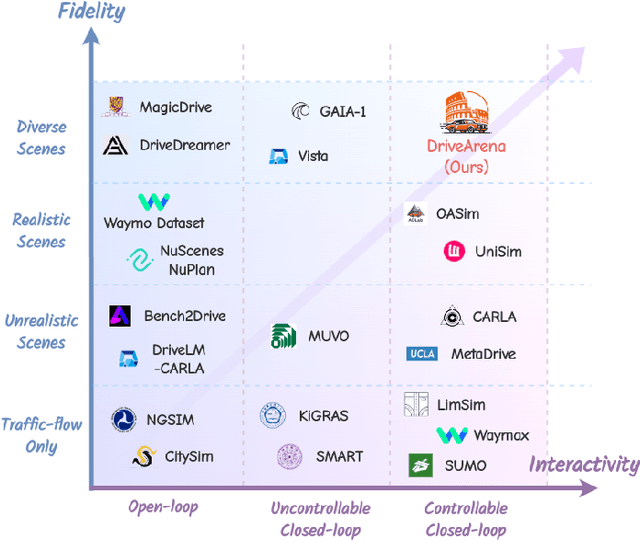

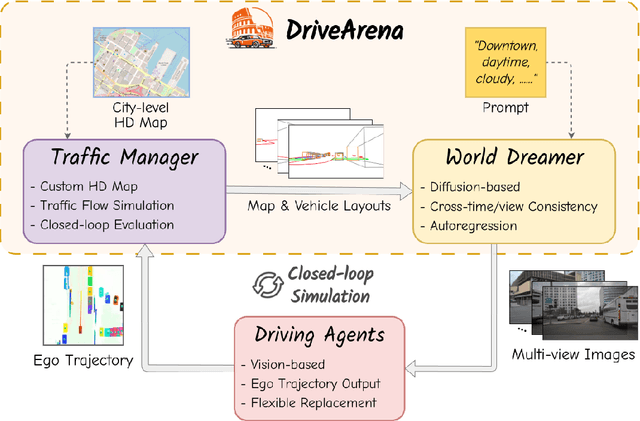

Abstract:This paper presented DriveArena, the first high-fidelity closed-loop simulation system designed for driving agents navigating in real scenarios. DriveArena features a flexible, modular architecture, allowing for the seamless interchange of its core components: Traffic Manager, a traffic simulator capable of generating realistic traffic flow on any worldwide street map, and World Dreamer, a high-fidelity conditional generative model with infinite autoregression. This powerful synergy empowers any driving agent capable of processing real-world images to navigate in DriveArena's simulated environment. The agent perceives its surroundings through images generated by World Dreamer and output trajectories. These trajectories are fed into Traffic Manager, achieving realistic interactions with other vehicles and producing a new scene layout. Finally, the latest scene layout is relayed back into World Dreamer, perpetuating the simulation cycle. This iterative process fosters closed-loop exploration within a highly realistic environment, providing a valuable platform for developing and evaluating driving agents across diverse and challenging scenarios. DriveArena signifies a substantial leap forward in leveraging generative image data for the driving simulation platform, opening insights for closed-loop autonomous driving. Code will be available soon on GitHub: https://github.com/PJLab-ADG/DriveArena
KoMA: Knowledge-driven Multi-agent Framework for Autonomous Driving with Large Language Models
Jul 19, 2024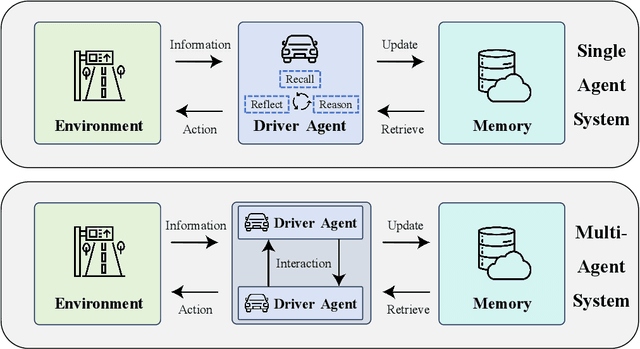
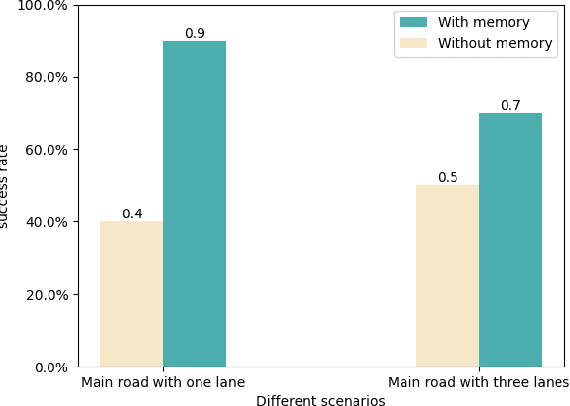
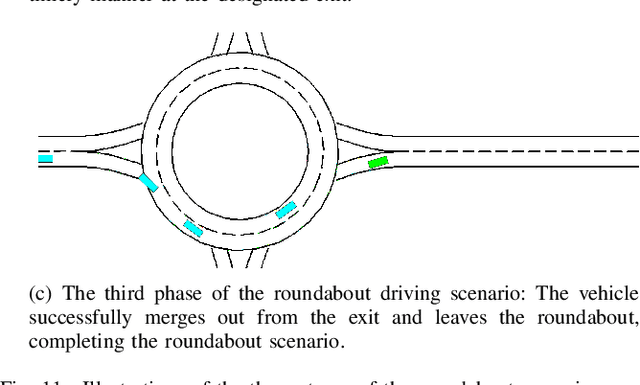
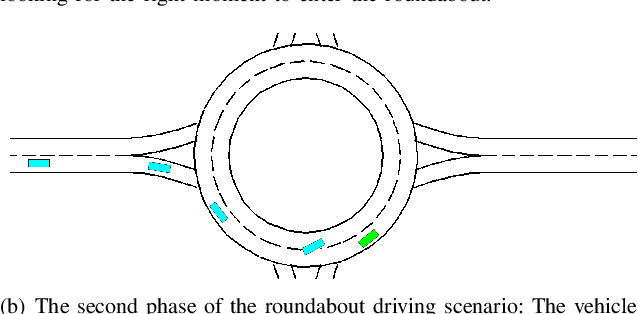
Abstract:Large language models (LLMs) as autonomous agents offer a novel avenue for tackling real-world challenges through a knowledge-driven manner. These LLM-enhanced methodologies excel in generalization and interpretability. However, the complexity of driving tasks often necessitates the collaboration of multiple, heterogeneous agents, underscoring the need for such LLM-driven agents to engage in cooperative knowledge sharing and cognitive synergy. Despite the promise of LLMs, current applications predominantly center around single agent scenarios. To broaden the horizons of knowledge-driven strategies and bolster the generalization capabilities of autonomous agents, we propose the KoMA framework consisting of multi-agent interaction, multi-step planning, shared-memory, and ranking-based reflection modules to enhance multi-agents' decision-making in complex driving scenarios. Based on the framework's generated text descriptions of driving scenarios, the multi-agent interaction module enables LLM agents to analyze and infer the intentions of surrounding vehicles, akin to human cognition. The multi-step planning module enables LLM agents to analyze and obtain final action decisions layer by layer to ensure consistent goals for short-term action decisions. The shared memory module can accumulate collective experience to make superior decisions, and the ranking-based reflection module can evaluate and improve agent behavior with the aim of enhancing driving safety and efficiency. The KoMA framework not only enhances the robustness and adaptability of autonomous driving agents but also significantly elevates their generalization capabilities across diverse scenarios. Empirical results demonstrate the superiority of our approach over traditional methods, particularly in its ability to handle complex, unpredictable driving environments without extensive retraining.
DocGenome: An Open Large-scale Scientific Document Benchmark for Training and Testing Multi-modal Large Language Models
Jun 17, 2024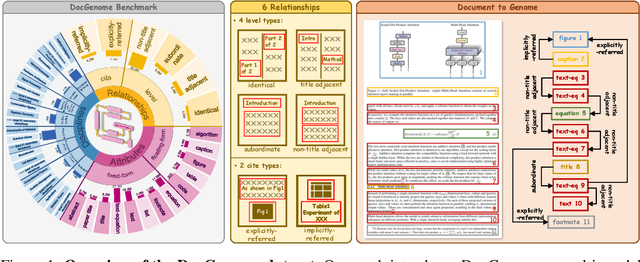


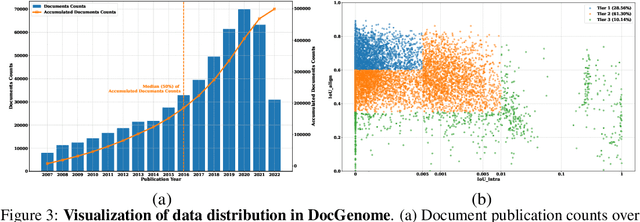
Abstract:Scientific documents record research findings and valuable human knowledge, comprising a vast corpus of high-quality data. Leveraging multi-modality data extracted from these documents and assessing large models' abilities to handle scientific document-oriented tasks is therefore meaningful. Despite promising advancements, large models still perform poorly on multi-page scientific document extraction and understanding tasks, and their capacity to process within-document data formats such as charts and equations remains under-explored. To address these issues, we present DocGenome, a structured document benchmark constructed by annotating 500K scientific documents from 153 disciplines in the arXiv open-access community, using our custom auto-labeling pipeline. DocGenome features four key characteristics: 1) Completeness: It is the first dataset to structure data from all modalities including 13 layout attributes along with their LaTeX source codes. 2) Logicality: It provides 6 logical relationships between different entities within each scientific document. 3) Diversity: It covers various document-oriented tasks, including document classification, visual grounding, document layout detection, document transformation, open-ended single-page QA and multi-page QA. 4) Correctness: It undergoes rigorous quality control checks conducted by a specialized team. We conduct extensive experiments to demonstrate the advantages of DocGenome and objectively evaluate the performance of large models on our benchmark.
OmniCorpus: A Unified Multimodal Corpus of 10 Billion-Level Images Interleaved with Text
Jun 13, 2024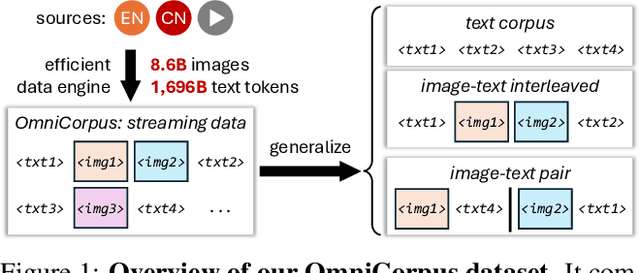
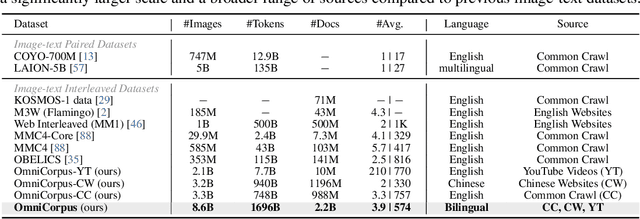


Abstract:Image-text interleaved data, consisting of multiple images and texts arranged in a natural document format, aligns with the presentation paradigm of internet data and closely resembles human reading habits. Recent studies have shown that such data aids multimodal in-context learning and maintains the capabilities of large language models during multimodal fine-tuning. However, the limited scale and diversity of current image-text interleaved data restrict the development of multimodal large language models. In this paper, we introduce OmniCorpus, a 10 billion-scale image-text interleaved dataset. Using an efficient data engine, we filter and extract large-scale high-quality documents, which contain 8.6 billion images and 1,696 billion text tokens. Compared to counterparts (e.g., MMC4, OBELICS), our dataset 1) has 15 times larger scales while maintaining good data quality; 2) features more diverse sources, including both English and non-English websites as well as video-centric websites; 3) is more flexible, easily degradable from an image-text interleaved format to pure text corpus and image-text pairs. Through comprehensive analysis and experiments, we validate the quality, usability, and effectiveness of the proposed dataset. We hope this could provide a solid data foundation for future multimodal model research. Code and data are released at https://github.com/OpenGVLab/OmniCorpus.
OmniCorpus: An Unified Multimodal Corpus of 10 Billion-Level Images Interleaved with Text
Jun 12, 2024



Abstract:Image-text interleaved data, consisting of multiple images and texts arranged in a natural document format, aligns with the presentation paradigm of internet data and closely resembles human reading habits. Recent studies have shown that such data aids multimodal in-context learning and maintains the capabilities of large language models during multimodal fine-tuning. However, the limited scale and diversity of current image-text interleaved data restrict the development of multimodal large language models. In this paper, we introduce OmniCorpus, a 10 billion-scale image-text interleaved dataset. Using an efficient data engine, we filter and extract large-scale high-quality documents, which contain 8.6 billion images and 1,696 billion text tokens. Compared to counterparts (e.g., MMC4, OBELICS), our dataset 1) has 15 times larger scales while maintaining good data quality; 2) features more diverse sources, including both English and non-English websites as well as video-centric websites; 3) is more flexible, easily degradable from an image-text interleaved format to pure text corpus and image-text pairs. Through comprehensive analysis and experiments, we validate the quality, usability, and effectiveness of the proposed dataset. We hope this could provide a solid data foundation for future multimodal model research. Code and data are released at https://github.com/OpenGVLab/OmniCorpus.
Continuously Learning, Adapting, and Improving: A Dual-Process Approach to Autonomous Driving
May 24, 2024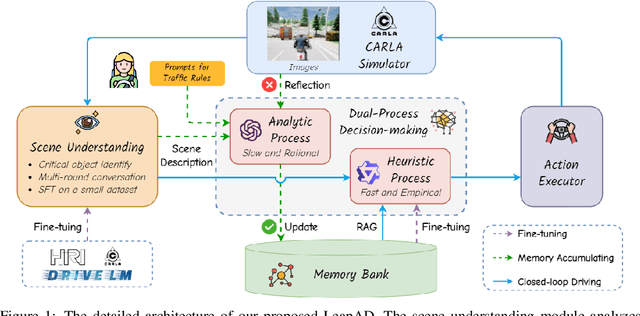
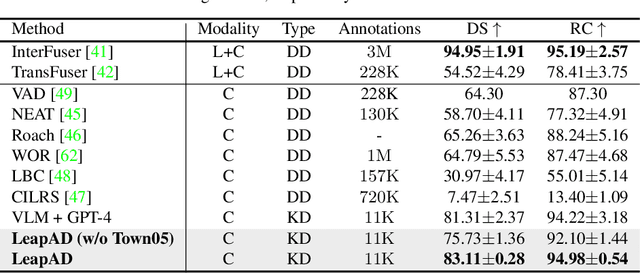
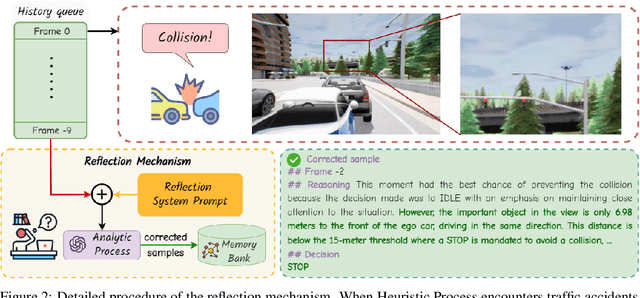

Abstract:Autonomous driving has advanced significantly due to sensors, machine learning, and artificial intelligence improvements. However, prevailing methods struggle with intricate scenarios and causal relationships, hindering adaptability and interpretability in varied environments. To address the above problems, we introduce LeapAD, a novel paradigm for autonomous driving inspired by the human cognitive process. Specifically, LeapAD emulates human attention by selecting critical objects relevant to driving decisions, simplifying environmental interpretation, and mitigating decision-making complexities. Additionally, LeapAD incorporates an innovative dual-process decision-making module, which consists of an Analytic Process (System-II) for thorough analysis and reasoning, along with a Heuristic Process (System-I) for swift and empirical processing. The Analytic Process leverages its logical reasoning to accumulate linguistic driving experience, which is then transferred to the Heuristic Process by supervised fine-tuning. Through reflection mechanisms and a growing memory bank, LeapAD continuously improves itself from past mistakes in a closed-loop environment. Closed-loop testing in CARLA shows that LeapAD outperforms all methods relying solely on camera input, requiring 1-2 orders of magnitude less labeled data. Experiments also demonstrate that as the memory bank expands, the Heuristic Process with only 1.8B parameters can inherit the knowledge from a GPT-4 powered Analytic Process and achieve continuous performance improvement. Code will be released at https://github.com/PJLab-ADG/LeapAD.
 Add to Chrome
Add to Chrome Add to Firefox
Add to Firefox Add to Edge
Add to Edge